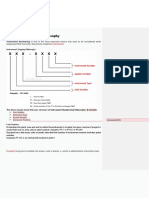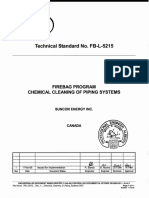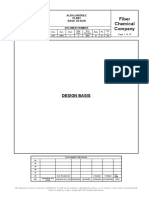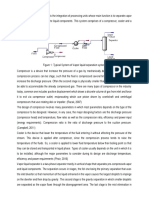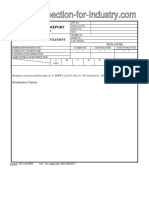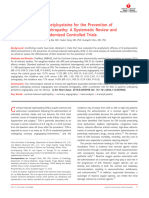Acrobat Document2 PDF
Acrobat Document2 PDF
Uploaded by
Khepa BabaCopyright:
Available Formats
Acrobat Document2 PDF
Acrobat Document2 PDF
Uploaded by
Khepa BabaOriginal Title
Copyright
Available Formats
Share this document
Did you find this document useful?
Is this content inappropriate?
Copyright:
Available Formats
Acrobat Document2 PDF
Acrobat Document2 PDF
Uploaded by
Khepa BabaCopyright:
Available Formats
By Md Aktaruzzaman at 3:58 pm, Jun 12, 2014
Process Design Calculations
Client: Chevron Bangladesh Block Twelve, Ltd.
Project: Bibiyana
Vessel Name: HP Separators
Vessel Tag: MBD-1000/ 1010/ 1020/ 1030
Rev. No.
Description of Revision
First Issue for Approval
Prepared
By
Date
PS
Checked / Approved
By
Date
28-Apr-2014
RB
6-May-2014
FMC Separation Systems B.V.
Delta 101
6825 MN Arnhem
The Netherlands
Tel: +31 26 7999 100
Fax: +31 26 7999 119
Client Order Number
Field / Platform
End User
Client Document Number
-
Standard Document Code: CWF-2.11
Revision Date: 02-Feb-2012
Bibiyana Gas Plant
Chevron Bangladesh
FMC Document Number
P12-11007-PDC
FMC Project No.
P12-11007
Rev. No.
1
No. of Pages
15
FMC Project No.:
FMC Doc. No. :
Revision :
P12-11007
P12-11007-PDC
1
Table of Contents
1.
Introduction ...................................................................................... 3
2.
Process Internals Overview................................................................. 3
3.
Process Description ............................................................................ 4
4.
3.1 CDS Inlet CycloneTM Inlet Device ................................................... 4
3.2 Distribution Baffles ....................................................................... 5
Process Flow Information ................................................................... 6
5.
Vessel Summary ................................................................................ 6
6.
Nozzle Schedule ................................................................................. 7
7.
Liquid Levels...................................................................................... 7
8.
Internal Details .................................................................................. 8
9.
8.1 CDS Inlet CycloneTM .................................................................... 8
8.2 Perforated Distribution Baffle(s) .................................................. 8
8.3 CDS Drained Meshpad AgglomeratorTM (Existing) ......................... 8
8.4 CDS SpiraflowTM (Existing) .......................................................... 8
8.5 Weir Plate (Existing) ................................................................... 8
8.6 Water Outlet Extension (Existing) ................................................ 9
8.7 Accessibility.............................................................................. 10
Process Guarantee ........................................................................... 11
10. Detailed Vessel Sizing Sheet ............................................................. 12
Page 2 of 15
FMC Project No.:
FMC Doc. No. :
Revision :
P12-11007
P12-11007-PDC
1
1. Introduction
This document is intended to describe the process design for the HP Separators (MBD-1000/ 1010/
1020/ 1030).
2. Process Internals Overview
The following process internals have been selected in the process design for this vessel.
CDS Inlet CycloneTM (new) and associated supports
Full Diameter Perforated Distribution Baffle (new) and associated supports
Partial Diameter Perforated Distribution Baffle (existing)
CSD Drained Meshpad AgglomeratorTM (existing)
CDS SpiraflowTM (existing)
Weir Plate (existing)
Interface Bolting and Gaskets for new internals
Notes:
1.
2.
3.
4.
Material of construction: Type 316 / 316L stainless steel.
Material of gaskets: Expanded PTFE.
No welding to the vessel wall is permitted for the installation of the internals.
Material certificates shall be in accordance with EN 10204 3.1 for base material with the
exception of bolting and gaskets that are to be in accordance with EN 10204 2.1.
5. All internals in FMC supply will be pickled and passivated.
6. All items in FMC supply will be made removable through the vessel manway.
Client scope of work
Installation of internals and associated supports
Preparation of vessel (removal of existing supports as per FMC demolition drawings)
Page 3 of 15
FMC Project No.:
FMC Doc. No. :
Revision :
P12-11007
P12-11007-PDC
1
3. Process Description
Further details of the internals are given below:
3.1 CDS Inlet CycloneTM Inlet Device
Since its development in 1998, the CDS Inlet CycloneTM inlet device has been continually optimized
with the CFD and in-house testing. The cyclone is successfully applied in many projects and is the
first inlet cyclone technology used subsea. The inlet cyclone cluster is designed to have a wide
operating window; design, number and size of the cyclones depends on the process conditions.
The CDS Inlet CycloneTM absorbs the high inlet momentum of the incoming process stream
converting the inlet velocity into centrifugal force. The centrifugal force drives liquid and gas
separation within the cyclones. The separated liquid leaves the cyclone through the bottom section
submerged in the process liquid. The gas exits the cyclone through the top section. The cyclone is
designed for different gas-to-oil ratios with high flexibility in operating range.
The CDS Inlet CycloneTM is designed to minimize shear and break-up of liquid droplets.
Furthermore, pressure drops in the cyclones are balanced to prevent liquid carry over and gas
carry under. Liquid carry over from the cyclone should be avoided to prevent a too high liquid load
on the downstream demister; gas carry under should be avoided to prevent foam generation and
gas re-entrainment in the liquid phase.
In applications where foaming occurs, the CDS Inlet CycloneTM reduces foam generation as a result
of the applied centrifugal forces and high gas from liquid removal efficiency.
Key benefits:
Well established technology
Proven performance optimized by CFD
Robust design with mechanical strength verified by FEA
Resistant to fouling and blocking
Flexible operating envelope for all gas/liquid ratios
Effectively dissipates high inlet momentum
Low shear forces
Mitigation of foam generation
Improves separation performance of vessel
Page 4 of 15
FMC Project No.:
FMC Doc. No. :
Revision :
P12-11007
P12-11007-PDC
1
3.2 Distribution Baffles
Perforated baffles are positioned in horizontal separators to achieve a number of process benefits:
The effects of high inlet momentum of incoming fluids are contained within the inlet zone
Distribute pressure drop across the vessel diameter creating plug flow
Resulting pressure drop promotes gas break out earlier in the separation zone.
Reduces impact of fluid volume surges from fluctuating process conditions.
Creates calm separation conditions to maximize the volume in the downstream quiescent
zone.
Reduce gas layer velocities, allowing for drop out of liquid droplets.
In floating applications, correct placement of baffles provides effective sloshing mitigation
The inlet momentum of multiphase fluid entering a separator vessel must be effectively contained
within the inlet zone while minimizing turbulence and shearing. Most of the momentum will be
dispersed by the inlet device ensuring good distribution of fluid flow across the inlet zone. When
fluctuating flow is experienced, changing velocities, phase ratios and slugging has the potential to
agitate the inlet zone. Baffles positioned downstream of the inlet device serve to contain surges
within the separator inlet zone.
Perforated baffles are designed with an open area between 20-40% creating the desired level of
pressure drop. By creating the pressure drop across the width of the vessel provides two direct
benefits to separation efficiency:
1. Ensuring plug flow. Using the full width of the vessel prevents jetting or short cutting
downstream towards the outlet nozzles
2. Gas phase hold up. Reduce gas phase velocity and liquid droplet entrainment towards the
downstream demisting devices.
The mechanical design of FMC Separation Systems perforated baffles is characterized by a
distinctive conical arrangement. Significant strength improvements are gained and large support
beams removed. Ease of fabrication and installation is improved with cost reductions over flat
baffle designs.
Page 5 of 15
FMC Project No.:
FMC Doc. No. :
Revision :
P12-11007
P12-11007-PDC
1
4. Process Flow Information
The proposed design is based on the process data provided in document titled Exhibit A
Specification HPSI Package received on 2 January 2014.
Case 1
Case 2
Case 3
Case 4
1075.00
100.00
1075.00
100.00
1075.00
100.00
1075.00
100.00
225.0
17.2
3.12
0.014000
225.0
17.2
3.12
0.014000
225.0
17.2
3.12
0.013000
225.0
17.2
3.12
0.012000
1500.0
43.40
0.490
1500.0
43.40
0.490
1834.0
44.20
0.540
2205.3
44.80
0.580
250.0
63.20
0.850
250.0
63.20
0.850
306.4
63.20
0.850
368.3
63.20
0.850
Environment
Pressure (psig)
Temperature (F)
Gas
Flow rate (MMSCFD)
MW
Density (lb/ft)
Viscosity (cP)
Oil
Flow rate (bbl/d)
Density (lb/ft)
Viscosity (cP)
Water
Flow rate (bbl/d)
Density (lb/ft)
Viscosity (cP)
5. Vessel Summary
Number of vessels
Horizontal or Vertical
Vessel internal diameter (mm /ft)
Tan to Tan Length (mm/ ft)
Head type
Four (4)
Horizontal
2134 / 7
6198 / 20 4
Elliptical
Page 6 of 15
FMC Project No.:
FMC Doc. No. :
Revision :
P12-11007
P12-11007-PDC
1
6. Nozzle Schedule
Location (mm/ ft)1
+ 965/ 3-2
+ 4776 / 15-8
Nozzle
A
B
Size ()/ID (mm)
12 / 289.05
12 / 289.05
4 / 97.28
4 / 97.28
+1575 / 5-2
Water Outlet
M1
M2
24/ 609.6
24 / 609.6
Downstream head
+ 2568 / 8-5
Manway
Manway
+ 4877 /
16-
Description
Inlet
Gas Outlet
Notes
Top Box
Gas Box (existing)
Oil Outlet
Vortex Breaker
(existing)
Water Outlet Extension
Vortex Breaker
(existing)
1. Location is taken from upstream tan line of vessel
7. Liquid Levels
Level
HHLL
HLL
NLL
LLL
LLLL
Weir
HIL
NIL
LIL
LLIL
Elevation1
(mm)
1016
914
813
762
610
610
457
381
178
102
1. From bottom of vessel
Page 7 of 15
FMC Project No.:
FMC Doc. No. :
Revision :
P12-11007
P12-11007-PDC
1
8. Internal Details
8.1 CDS Inlet CycloneTM
Inlet Cyclone
Number of Cyclones
Cyclone Internal Diameter (mm)
Cyclone Bottom Elevation (mm)1
Distributor Box Centreline elevation (mm)1
Inlet Arrangement
Four (4)
500 / 150
245
1700
Top Box
1. Elevation is taken from bottom of vessel
8.2 Perforated Distribution Baffle(s)
Perforated Distribution Baffle(s)
Full or Part Diameter Baffle
Height of Part Diameter Baffle (mm)
Perforation (% Net Free Area)
Diameter holes (mm)
Location of baffle (mm)1
Type of baffle
Note
1.
2.
#1
Full
2134
36
30
1865 mm
Flat
New baffle
#2
Part
1116
21
30
2065 mm
Flat
Existing baffle to be
shifted downstream to
the new location2
Location is taken from upstream tan line of vessel
The existing baffle to be re-used with modification to allow for the water outlet extension pipe to pass through
8.3 CDS Drained Meshpad AgglomeratorTM (Existing)
Mesh Pad Agglomerator (Horizontal Vessel)
Existing (no modifications are required)
8.4 CDS SpiraflowTM (Existing)
Spiraflow 80 Cyclone Deck
Existing (no modifications are required)
1. Elevation is taken from bottom tan line of vessel
8.5 Weir Plate (Existing)
Weir Plate
Existing (no modifications are required)
Page 8 of 15
FMC Project No.:
FMC Doc. No. :
Revision :
P12-11007
P12-11007-PDC
1
8.6 Water Outlet Extension (Existing)
Water Outlet Extension
Existing (no modifications are required)
Page 9 of 15
FMC Project No.:
FMC Doc. No. :
Revision :
P12-11007
P12-11007-PDC
1
8.7 Accessibility
All internals are installable and removable via the manway. Client is requested to inform FMC
about the available space around the separator and accessibility to the manway. Obstructions near
the vessel and manway must be clearly indicated prior to design. This in order to prevent that
parts of the internals will not be able to enter the vessel.
Page 10 of 15
FMC Project No.:
FMC Doc. No. :
Revision :
P12-11007
P12-11007-PDC
1
9. Process Guarantee
Based on the equipment being stored, erected and operated in accordance with FMC instructions
we guarantee the following.
Liquid Entrainment in Gas
The overall liquid carryover at high-high liquid level, neglecting the effect of condensation across
the vessel due to pressure drop, will not exceed 0.1 USG/MMSCF.
Page 11 of 15
FMC Project No.:
FMC Doc. No. :
Revision :
P12-11007
P12-11007-PDC
1
10. Detailed Vessel Sizing Sheet
Case number : 1
Case title : Case 1
Including head volume : y
Process summary
Oil
Pressure =
1075.00 psig
Temperature =
100.0 F
Flow :
Density :
Viscosity :
Surface tension :
1500.0
43.40
0.490
20.00
Water
bbl/d
lb/ft
cP
dyne/cm
250.0
63.20
0.850
70.00
Gas
bbl/d
lb/ft
cP
dyne/cm
225.0 MMRft/d
3.12 lb/ft
0.014 cP
Vessel data
2 or 3 phase :
Internal diameter :
Tan to Tan length :
Hemi or 2:1 heads :
Split Flow? :
End or Central Inlet :
Maximum pitch :
Mist eliminator :
Cyclone or vane mist eliminator :
Vane type :
Sizing K factor :
3
2.134
6.198
E
N
C
0.00
Y
C
CDS 250
0.150
m/s
Minimum Tan to Tan Length :
Total vessel volume :
Bottom of cyclone elevation :
Max liquid level under cyclones :
4.230
24.70
1544
1016
m
m
mm
mm
m
m
(H/E)
(c/v)
Inlet Cyclone :
Mesh Agglomerator :
Mesh thickness :
Coalescer Plate Pack :
Plate Spacing :
Plate Angle :
Plate Length :
Weir Plate :
Tan to Weir Length :
Liquid separating length :
Gas separating length :
Y
Y
0.100
N
0.010
45
1.000
Y
4.305
4.198
4.198
Actual drainage head :
Required drainage head :
Mesh lower elevation :
528 mm
444 mm
1.016 m
m
m
m
m
m
m
Nozzle Table
Fluid Inlet
Mesh Coalescer
Spira-flow 80 cyclones
Gas Outlet
Oil Outlet
Water Outlet
N.B
(in)
I.D
(m)
Minimum I.D
(m)
Velocity
(m/s)
rho-v
(kg/ms)
Pressure drop
(mbar)
12
0.289
0.285
16.37
0.56
13950
16
21% NFA
12
4
4
0.289
0.097
0.097
0.310
0.051
0.021
16.32
0.37
0.06
13315
140
3
54
40
'K' value
0.157
Volume between
levels
(m)
Residence
time
(mins)
1.52
1.48
3.83
0.74
2.11
1.85
9.19
8.96
23.13
4.44
12.75
11.17
Liquid levels
Gas space above
HHLL
1.118
0.565
m
m/s
Level
Level
(m)
Vessel fill
(%)
HHLL
HLL
NLL
NLL
LLL
LLLL
1.016
0.914
0.813
0.813
0.762
0.610
47.6
42.8
38.1
38.1
35.7
28.6
Top of weir
0.610
28.6
1.32
47.74
HIL
NIL
NIL
LIL
LLIL
0.457
0.381
0.381
0.178
0.102
21.4
17.9
17.9
8.3
4.8
0.60
1.97
1.33
0.36
0.28
21.64
71.36
48.22
13.08
10.06
Axial velocity
(m/s)
0.003
0.001
Reynolds
Number
m/s
Interval
HLL to
NLL to
NLL to
LLL to
LLLL to
Liquid Outlet to
HHLL
HLL
NIL
NLL
LLL
LLLL
HIL to Top of weir
NIL to
BV to
LIL to
LLIL to
BV to
HIL
NIL
NIL
LIL
LLIL
Page 12 of 15
FMC Project No.:
FMC Doc. No. :
Revision :
P12-11007
P12-11007-PDC
1
Case number : 2
Case title : Case 2
Including head volume : y
Process summary
Oil
Pressure =
1075.00 psig
Temperature =
100.0 F
Flow :
Density :
Viscosity :
Surface tension :
1500.0
43.40
0.490
20.00
Water
bbl/d
lb/ft
cP
dyne/cm
250.0
63.20
0.850
70.00
Gas
bbl/d
lb/ft
cP
dyne/cm
225.0 MMRft/d
3.12 lb/ft
0.014 cP
Vessel data
2 or 3 phase :
Internal diameter :
Tan to Tan length :
Hemi or 2:1 heads :
Split Flow? :
End or Central Inlet :
Maximum pitch :
Mist eliminator :
Cyclone or vane mist eliminator :
Vane type :
Sizing K factor :
3
2.134
6.198
E
N
C
0.00
Y
C
CDS 250
0.150
Minimum Tan to Tan Length :
Total vessel volume :
Bottom of cyclone elevation :
Max liquid level under cyclones :
4.230
24.70
1544
1016
m
m
(H/E)
(c/v)
m/s
Inlet Cyclone :
Mesh Agglomerator :
Mesh thickness :
Coalescer Plate Pack :
Plate Spacing :
Plate Angle :
Plate Length :
Weir Plate :
Tan to Weir Length :
Liquid separating length :
Gas separating length :
Y
Y
0.100
N
0.010
45
1.000
Y
4.305
4.198
4.198
Actual drainage head :
Required drainage head :
Mesh lower elevation :
528 mm
444 mm
1.016 m
m
m
mm
mm
m
m
m
m
m
m
Nozzle Table
Fluid Inlet
Mesh Coalescer
Spira-flow 80 cyclones
Gas Outlet
Oil Outlet
Water Outlet
N.B
(in)
I.D
(m)
Minimum I.D
(m)
Velocity
(m/s)
rho-v
(kg/ms)
Pressure drop
(mbar)
12
0.289
0.285
16.37
0.56
13950
16
21% NFA
12
4
4
0.289
0.097
0.097
0.310
0.051
0.021
16.32
0.37
0.06
13315
140
3
54
40
'K' value
0.157
Volume between
levels
(m)
Residence
time
(mins)
1.52
1.48
3.83
0.74
2.11
1.85
9.19
8.96
23.13
4.44
12.75
11.17
Liquid levels
Gas space above
HHLL
1.118
0.565
m
m/s
Level
Level
(m)
Vessel fill
(%)
HHLL
HLL
NLL
NLL
LLL
LLLL
1.016
0.914
0.813
0.813
0.762
0.610
47.6
42.8
38.1
38.1
35.7
28.6
Top of weir
0.610
28.6
1.32
47.74
HIL
NIL
NIL
LIL
LLIL
0.457
0.381
0.381
0.178
0.102
21.4
17.9
17.9
8.3
4.8
0.60
1.97
1.33
0.36
0.28
21.64
71.36
48.22
13.08
10.06
Axial velocity
(m/s)
0.003
0.001
Reynolds
Number
m/s
Interval
HLL to
NLL to
NLL to
LLL to
LLLL to
Liquid Outlet to
HHLL
HLL
NIL
NLL
LLL
LLLL
HIL to Top of weir
NIL to
BV to
LIL to
LLIL to
BV to
HIL
NIL
NIL
LIL
LLIL
Page 13 of 15
FMC Project No.:
FMC Doc. No. :
Revision :
P12-11007
P12-11007-PDC
1
Case number : 3
Case title : Case 3
Including head volume : y
Process summary
Oil
Pressure =
1075.00 psig
Temperature =
100.0 F
Flow :
Density :
Viscosity :
Surface tension :
1834.0
44.20
0.540
20.00
Water
bbl/d
lb/ft
cP
dyne/cm
306.4
63.20
0.850
70.00
Gas
bbl/d
lb/ft
cP
dyne/cm
225.0 MMRft/d
3.12 lb/ft
0.013 cP
Vessel data
2 or 3 phase :
Internal diameter :
Tan to Tan length :
Hemi or 2:1 heads :
Split Flow? :
End or Central Inlet :
Maximum pitch :
Mist eliminator :
Cyclone or vane mist eliminator :
Vane type :
Sizing K factor :
3
2.134
6.198
E
N
C
0.00
Y
C
CDS 250
0.150
m/s
Minimum Tan to Tan Length :
Total vessel volume :
Bottom of cyclone elevation :
Max liquid level under cyclones :
4.230
24.70
1544
1016
m
m
mm
mm
m
m
(H/E)
(c/v)
Inlet Cyclone :
Mesh Agglomerator :
Mesh thickness :
Coalescer Plate Pack :
Plate Spacing :
Plate Angle :
Plate Length :
Weir Plate :
Tan to Weir Length :
Liquid separating length :
Gas separating length :
Y
Y
0.100
N
0.010
45
1.000
Y
4.305
4.198
4.198
Actual drainage head :
Required drainage head :
Mesh lower elevation :
528 mm
438 mm
1.016 m
m
m
m
m
m
m
Nozzle Table
Fluid Inlet
Mesh Coalescer
Spira-flow 80 cyclones
Gas Outlet
Oil Outlet
Water Outlet
N.B
(in)
I.D
(m)
Minimum I.D
(m)
Velocity
(m/s)
rho-v
(kg/ms)
Pressure drop
(mbar)
12
0.289
0.285
16.38
0.56
14103
16
21% NFA
12
4
4
0.289
0.097
0.097
0.310
0.051
0.021
16.32
0.45
0.08
13315
141
3
54
40
'K' value
0.156
Volume between
levels
(m)
Residence
time
(mins)
1.52
1.48
3.83
0.74
2.11
1.85
7.52
7.33
18.92
3.63
10.43
9.13
Liquid levels
Gas space above
HHLL
1.118
0.565
m
m/s
Level
Level
(m)
Vessel fill
(%)
HHLL
HLL
NLL
NLL
LLL
LLLL
1.016
0.914
0.813
0.813
0.762
0.610
47.6
42.8
38.1
38.1
35.7
28.6
Top of weir
0.610
28.6
1.32
38.95
HIL
NIL
NIL
LIL
LLIL
0.457
0.381
0.381
0.178
0.102
21.4
17.9
17.9
8.3
4.8
0.60
1.97
1.33
0.36
0.28
17.65
58.22
39.34
10.67
8.21
Axial velocity
(m/s)
0.004
0.001
Reynolds
Number
m/s
Interval
HLL to
NLL to
NLL to
LLL to
LLLL to
Liquid Outlet to
HHLL
HLL
NIL
NLL
LLL
LLLL
HIL to Top of weir
NIL to
BV to
LIL to
LLIL to
BV to
HIL
NIL
NIL
LIL
LLIL
Page 14 of 15
FMC Project No.:
FMC Doc. No. :
Revision :
P12-11007
P12-11007-PDC
1
Case number : 4
Case title : Case 4
Including head volume : y
Process summary
Oil
Pressure =
1075.00 psig
Temperature =
100.0 F
Flow :
Density :
Viscosity :
Surface tension :
2205.3
44.80
0.580
20.00
Water
bbl/d
lb/ft
cP
dyne/cm
368.3
63.20
0.850
70.00
Gas
bbl/d
lb/ft
cP
dyne/cm
225.0 MMRft/d
3.12 lb/ft
0.012 cP
Vessel data
2 or 3 phase :
Internal diameter :
Tan to Tan length :
Hemi or 2:1 heads :
Split Flow? :
End or Central Inlet :
Maximum pitch :
Mist eliminator :
Cyclone or vane mist eliminator :
Vane type :
Sizing K factor :
3
2.134
6.198
E
N
C
0.00
Y
C
CDS 250
0.150
m/s
Minimum Tan to Tan Length :
Total vessel volume :
Bottom of cyclone elevation :
Max liquid level under cyclones :
4.230
24.70
1544
1016
m
m
mm
mm
m
m
(H/E)
(c/v)
Inlet Cyclone :
Mesh Agglomerator :
Mesh thickness :
Coalescer Plate Pack :
Plate Spacing :
Plate Angle :
Plate Length :
Weir Plate :
Tan to Weir Length :
Liquid separating length :
Gas separating length :
Y
Y
0.100
N
0.010
45
1.000
Y
4.305
4.198
4.198
Actual drainage head :
Required drainage head :
Mesh lower elevation :
528 mm
434 mm
1.016 m
m
m
m
m
m
m
Nozzle Table
Fluid Inlet
Mesh Coalescer
Spira-flow 80 cyclones
Gas Outlet
Oil Outlet
Water Outlet
N.B
(in)
I.D
(m)
Minimum I.D
(m)
Velocity
(m/s)
rho-v
(kg/ms)
Pressure drop
(mbar)
12
0.289
0.285
16.39
0.56
14273
16
21% NFA
12
4
4
0.289
0.097
0.097
0.310
0.051
0.021
16.32
0.55
0.09
13315
143
3
54
40
'K' value
0.155
Volume between
levels
(m)
Residence
time
(mins)
1.52
1.48
3.83
0.74
2.11
1.85
6.25
6.10
15.73
3.02
8.67
7.59
Liquid levels
Gas space above
HHLL
1.118
0.565
m
m/s
Level
Level
(m)
Vessel fill
(%)
HHLL
HLL
NLL
NLL
LLL
LLLL
1.016
0.914
0.813
0.813
0.762
0.610
47.6
42.8
38.1
38.1
35.7
28.6
Top of weir
0.610
28.6
1.32
32.40
HIL
NIL
NIL
LIL
LLIL
0.457
0.381
0.381
0.178
0.102
21.4
17.9
17.9
8.3
4.8
0.60
1.97
1.33
0.36
0.28
14.69
48.44
32.73
8.88
6.83
Axial velocity
(m/s)
0.005
0.002
Reynolds
Number
m/s
Interval
HLL to
NLL to
NLL to
LLL to
LLLL to
Liquid Outlet to
HHLL
HLL
NIL
NLL
LLL
LLLL
HIL to Top of weir
NIL to
BV to
LIL to
LLIL to
BV to
HIL
NIL
NIL
LIL
LLIL
Page 15 of 15
You might also like
- Managing Ageing Plant - HSE UKDocument101 pagesManaging Ageing Plant - HSE UKLaurentiu LaurNo ratings yet
- Acrobat Document2 PDFDocument15 pagesAcrobat Document2 PDFeino6622No ratings yet
- API 571 Corrosion and Materials ProfessionalDocument2 pagesAPI 571 Corrosion and Materials ProfessionalKhepa BabaNo ratings yet
- OET Reading Test 2 - Part BDocument16 pagesOET Reading Test 2 - Part BLOTSOFTESTS100% (5)
- How A Polymer Get Dissolves?Document3 pagesHow A Polymer Get Dissolves?Vijay ChaudharyNo ratings yet
- Static Equipment - A Look Inside The How and Why' of SpecificationDocument16 pagesStatic Equipment - A Look Inside The How and Why' of SpecificationmatodelanusNo ratings yet
- 37 FA10871C J 01 - REV D Design Instruction MechDocument117 pages37 FA10871C J 01 - REV D Design Instruction Mecharunrajmech09No ratings yet
- FW HydraulicsDocument59 pagesFW HydraulicsSHAILENDRANo ratings yet
- LFL Temp MW V% in Air Deg C G/mole 1.7 25 72Document4 pagesLFL Temp MW V% in Air Deg C G/mole 1.7 25 72SHAILENDRANo ratings yet
- Release RateDocument134 pagesRelease RateSHAILENDRANo ratings yet
- Scrubbing Tower DesignDocument10 pagesScrubbing Tower DesignPrathmesh GujaratiNo ratings yet
- 7 Work Packages Deliverables Milestones PDFDocument10 pages7 Work Packages Deliverables Milestones PDFSulist N WahyudieNo ratings yet
- 100 Introduction To Fire PreventionDocument22 pages100 Introduction To Fire PreventionSHAILENDRANo ratings yet
- 2495 000 JSD 1501 01 - BDocument30 pages2495 000 JSD 1501 01 - BSinaNo ratings yet
- Jacobs Calculations 2Document2 pagesJacobs Calculations 2BhattNo ratings yet
- Cent Pump OperationDocument5 pagesCent Pump OperationTamer Abd ElrasoulNo ratings yet
- CEPCI CalculationDocument9 pagesCEPCI CalculationChelsea SkinnerNo ratings yet
- 01 - Corporate Piping-Mechanical ProceduresDocument2 pages01 - Corporate Piping-Mechanical Proceduresyusuf.yuzuakNo ratings yet
- Cefic Solvay Guidelines PDFBR 1770 C-b-1-0602 - H2o2Document48 pagesCefic Solvay Guidelines PDFBR 1770 C-b-1-0602 - H2o2Mark CousinsNo ratings yet
- Instrument Numbering PhilosophyDocument3 pagesInstrument Numbering PhilosophyVraja KisoriNo ratings yet
- BG-06221ID - Form Inspection PDFDocument100 pagesBG-06221ID - Form Inspection PDFYogaswaraNo ratings yet
- Suncor: Technical Standard No - FB - L-521 5Document13 pagesSuncor: Technical Standard No - FB - L-521 5rezzdezzNo ratings yet
- Equipment EngineeringDocument131 pagesEquipment EngineeringHervéNo ratings yet
- Viscosity-1 Viscometer-2 Relation Between Viscosity &temperature-3 Vogel Equation-4 Programming ofDocument71 pagesViscosity-1 Viscometer-2 Relation Between Viscosity &temperature-3 Vogel Equation-4 Programming ofDr_M_SolimanNo ratings yet
- BepDocument4 pagesBepkashifwarsiNo ratings yet
- Design of Packed ColumnDocument4 pagesDesign of Packed Columnمنى عبد المنعم صالح رداد منى عبد المنعم صالح ردادNo ratings yet
- PRV PetrofacDocument36 pagesPRV PetrofacPradeep MagudeswaranNo ratings yet
- Decanter Design (Present Ni)Document9 pagesDecanter Design (Present Ni)Fiza Nnazlan0% (1)
- Stoichiometry and Process Calculations - K. v. Narayanan and B. LakshmikuttyDocument167 pagesStoichiometry and Process Calculations - K. v. Narayanan and B. LakshmikuttyNandithNo ratings yet
- Updating The Rules For Pipe SizingDocument5 pagesUpdating The Rules For Pipe SizingBehroozRaadNo ratings yet
- Saudi Aramco Inspection ChecklistDocument7 pagesSaudi Aramco Inspection Checklistpookkoya thangalNo ratings yet
- Vessels Layout ConceptsDocument38 pagesVessels Layout ConceptsAbdou SebtiNo ratings yet
- 2-Vertical Separator PDFDocument1 page2-Vertical Separator PDFSudarshan GopalNo ratings yet
- Phe PDSDocument4 pagesPhe PDSprabhuarunkumarNo ratings yet
- 71.0402 General Construction - Substructures - AssemblyDocument201 pages71.0402 General Construction - Substructures - Assemblythanhphucbr87No ratings yet
- 000 Pe DS 0001Document5 pages000 Pe DS 0001Dar FallNo ratings yet
- PSV-1203 - 3632-I-DS-31001 WorkingDocument1 pagePSV-1203 - 3632-I-DS-31001 Workinganamaria ursuNo ratings yet
- BZ Est PD 002 Control Philosophy TestDocument55 pagesBZ Est PD 002 Control Philosophy TestMertoiu GabrielNo ratings yet
- P RefStd - 4043 - v091130 - EN - LOPADocument18 pagesP RefStd - 4043 - v091130 - EN - LOPAMeoNo ratings yet
- RB - Specifications Piping MaterialsDocument21 pagesRB - Specifications Piping MaterialsFalcon PeregrinusNo ratings yet
- Design BasisDocument12 pagesDesign BasisrezaNo ratings yet
- 214690C-000-SOW-1410-0001 - REV A - SignedDocument39 pages214690C-000-SOW-1410-0001 - REV A - SignedMohamed AskarNo ratings yet
- Heat Transfer Equipment 2. Boiling and CondensingDocument20 pagesHeat Transfer Equipment 2. Boiling and CondensingRicardo Franco ArboledaNo ratings yet
- 4 InflowDocument24 pages4 InflowmsvaletNo ratings yet
- IncineratorDocument9 pagesIncinerator3668770No ratings yet
- Equivalent Length MethodDocument1 pageEquivalent Length MethodSufi SyarifNo ratings yet
- 6817 PR CN 0601 RevA (ReviewCheck)Document1 page6817 PR CN 0601 RevA (ReviewCheck)Nhật Quang Phạm0% (1)
- ASPEN Design of Vap-Liq Separator EdtDocument6 pagesASPEN Design of Vap-Liq Separator EdtethanNo ratings yet
- DR - Reciprocating Compressor Table of Contents (Process)Document5 pagesDR - Reciprocating Compressor Table of Contents (Process)rutujaNo ratings yet
- Centrifugal Compressor Construction and TestingDocument10 pagesCentrifugal Compressor Construction and Testingmusaveer50% (2)
- Parker Hyd PDFDocument460 pagesParker Hyd PDFAugusto RezendeNo ratings yet
- How To Find Energy Savings in Process Plants PDFDocument13 pagesHow To Find Energy Savings in Process Plants PDFCamilo RuaNo ratings yet
- KSB Know-How, Volume 0 - Selecting-Centrifugal-Pumps-data PDFDocument92 pagesKSB Know-How, Volume 0 - Selecting-Centrifugal-Pumps-data PDFRodrigo Astudillo AedoNo ratings yet
- WATSON Separator 1Document31 pagesWATSON Separator 1Apriliana DwijayantiNo ratings yet
- HFY4-5165-01-PIP-PD-0001 - 1 - Piping Pressure Test and Flushing Procedure-Code-ADocument16 pagesHFY4-5165-01-PIP-PD-0001 - 1 - Piping Pressure Test and Flushing Procedure-Code-Asafaa.xynmNo ratings yet
- Sewers For Adoption 7th Edition - WW Amendments Oct 2013Document15 pagesSewers For Adoption 7th Edition - WW Amendments Oct 2013Roger Andres Ordoñez100% (1)
- C 84514 BK KK0 PRO GN 00 0014 Subsea Pre Commissioning Procedure - Rev.0BDocument65 pagesC 84514 BK KK0 PRO GN 00 0014 Subsea Pre Commissioning Procedure - Rev.0BFAR_A_DAY100% (3)
- Amended Silicate SorbDocument45 pagesAmended Silicate SorbAzeam AnjumNo ratings yet
- SRV Detaisl Awa Salawas PDFDocument222 pagesSRV Detaisl Awa Salawas PDFdiwakarngm100% (1)
- .Reaming While DrillingDocument12 pages.Reaming While DrillinglandysponceNo ratings yet
- Acrobat Document PDFDocument1 pageAcrobat Document PDFKhepa BabaNo ratings yet
- NEW para 10 BanglaQuran PronunciationAndTranslationDocument28 pagesNEW para 10 BanglaQuran PronunciationAndTranslationKhepa BabaNo ratings yet
- COM-SU-5191 Chevron Onshore Painting Specification PDFDocument157 pagesCOM-SU-5191 Chevron Onshore Painting Specification PDFKhepa Baba100% (1)
- Dye Penetrant Test: Lipse Engineering ServicesDocument9 pagesDye Penetrant Test: Lipse Engineering ServicesKhepa BabaNo ratings yet
- COM-SU-5191 Chevron Onshore Painting Specification PDFDocument157 pagesCOM-SU-5191 Chevron Onshore Painting Specification PDFKhepa Baba100% (1)
- Case N-4-11 Special Type 403 Modified Forgings or Bars Section III, Division 1, Class 1 and CSDocument2 pagesCase N-4-11 Special Type 403 Modified Forgings or Bars Section III, Division 1, Class 1 and CSKhepa BabaNo ratings yet
- Dye Penetrant Test: Lipse Engineering ServicesDocument9 pagesDye Penetrant Test: Lipse Engineering ServicesKhepa BabaNo ratings yet
- Storage Tank Foundation Settlement Quality Control and Inspection Report FormDocument1 pageStorage Tank Foundation Settlement Quality Control and Inspection Report FormKhepa Baba100% (1)
- Radiographic Examinatio Report: Client: Chevron BD LTD Project: JBGP Acceptance StandardDocument1 pageRadiographic Examinatio Report: Client: Chevron BD LTD Project: JBGP Acceptance StandardKhepa BabaNo ratings yet
- Chevron SOP-45, ScaffoldingDocument40 pagesChevron SOP-45, ScaffoldingKhepa Baba50% (2)
- BGDDY6F40115NA891231Document2 pagesBGDDY6F40115NA891231Khepa BabaNo ratings yet
- INTEGRATED Inspection & ExaminationDocument77 pagesINTEGRATED Inspection & ExaminationKhepa BabaNo ratings yet
- Lesson 5 - DistortionDocument22 pagesLesson 5 - DistortionKhepa BabaNo ratings yet
- Eazy CLOT User ManualDocument29 pagesEazy CLOT User ManualKarthik RajaNo ratings yet
- Rodriguez Asynch 2Document2 pagesRodriguez Asynch 2Kkab ShiiiNo ratings yet
- Backgrounder Flood Damage 130911 FINALDocument3 pagesBackgrounder Flood Damage 130911 FINALBarangay DitumaboNo ratings yet
- Wiring Instructions enDocument8 pagesWiring Instructions envizanteaNo ratings yet
- ACCE 312 Financial Statement Formats - EngDocument6 pagesACCE 312 Financial Statement Formats - EngPETER MABASSONo ratings yet
- Modul PKP Bi (JUN-JULAI)Document14 pagesModul PKP Bi (JUN-JULAI)Auji LeeNo ratings yet
- Sample Resume For FreshersDocument3 pagesSample Resume For FreshersFresh EpicNo ratings yet
- Green, M. A., Et Al. Solar Cell Efficiency Tables (Version 55) .Document13 pagesGreen, M. A., Et Al. Solar Cell Efficiency Tables (Version 55) .gxf980518No ratings yet
- Music and Regaining Calm When Faced With Academic StressDocument14 pagesMusic and Regaining Calm When Faced With Academic StressREYNAN OMONGAYONNo ratings yet
- Liver Flush and Liver Cleansing - Q&A by Andreas MoritzDocument25 pagesLiver Flush and Liver Cleansing - Q&A by Andreas Moritzfabienne.negoce7No ratings yet
- ObesidDocument10 pagesObesidrvp.180088No ratings yet
- Pathfit 1Document2 pagesPathfit 1Brian AnggotNo ratings yet
- 09000002807b0dfc 09000002807b0dfcDocument30 pages09000002807b0dfc 09000002807b0dfccitationxpilot85No ratings yet
- SA Originality Report PrintDocument16 pagesSA Originality Report PrintSiliziwe DipaNo ratings yet
- Sportsmetrics Jump TrainingDocument1 pageSportsmetrics Jump TrainingSean MceachernNo ratings yet
- First-Hand - Discovery of Superconductivity at 93 K in YBCO - The View From Ground Zero - ETHWDocument104 pagesFirst-Hand - Discovery of Superconductivity at 93 K in YBCO - The View From Ground Zero - ETHWVICTOR MATHEUS MORAIS CORREIANo ratings yet
- F Exam 2024Document9 pagesF Exam 2024maniaiah62No ratings yet
- Internship Report - ShivaliDocument39 pagesInternship Report - ShivaliDhanapan KeithellakpamNo ratings yet
- Final Year16 Oct. 21 Evening - 2.30 To 3.40 P.M. Seating Arrangment - MSE Oct. 2021Document72 pagesFinal Year16 Oct. 21 Evening - 2.30 To 3.40 P.M. Seating Arrangment - MSE Oct. 2021parth waghNo ratings yet
- Mathematics PracticeDocument2 pagesMathematics PracticeHishq DhimanNo ratings yet
- Effectiveness of N-Acetylcysteine For The Prevention of Contrast Induced NephropathyDocument31 pagesEffectiveness of N-Acetylcysteine For The Prevention of Contrast Induced NephropathyeeleeNo ratings yet
- Allergy Overview: - Nomenclature - Pathophysiology - Diagnosis - ManagementDocument96 pagesAllergy Overview: - Nomenclature - Pathophysiology - Diagnosis - ManagementPhaimNo ratings yet
- The Miracle Plant Kalanchoe Pinnata A PhytochemicaDocument6 pagesThe Miracle Plant Kalanchoe Pinnata A PhytochemicaEvgyrt NesralNo ratings yet
- HowtoapplyDocument4 pagesHowtoapplySrinivas VCENo ratings yet
- DB2 10.1 Part NumbersDocument4 pagesDB2 10.1 Part Numbersmana1345No ratings yet
- HUM 2234 Enlightenment and Romanticism: Fall 2016 Syllabus and ScheduleDocument5 pagesHUM 2234 Enlightenment and Romanticism: Fall 2016 Syllabus and ScheduleCinzNo ratings yet
- ZopenerDocument3 pagesZopenerSaiful AyyasNo ratings yet
- Gmail - Brownie Pets BadgeDocument2 pagesGmail - Brownie Pets Badgeapi-454987981No ratings yet
- 22 BBookDocument173 pages22 BBookKevin LeNo ratings yet




















